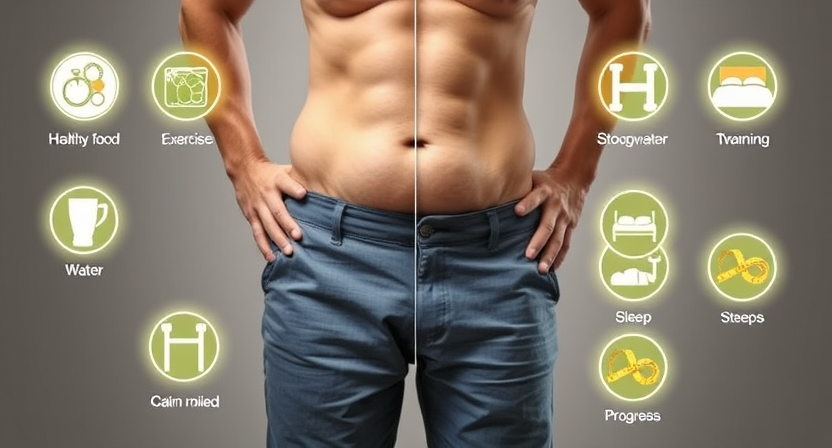
The Truth About Belly Fat: 7 Proven Ways to Get Rid of It
Signs of Excess Belly Fat

Excess belly fat can manifest itself in various ways. One common sign is a protruding abdomen that appears round and bulging, even when the rest of the body may seem relatively slim. This abdominal bulge is often referred to as a “beer belly” or “spare tire” and can indicate a buildup of visceral fat around the organs in the abdominal cavity. Additionally, having difficulty buttoning up trousers or feeling a tightness in the waistband may also indicate the presence of excess belly fat.
Another sign of excess belly fat is the measurement of waist circumference. A waist circumference of more than 40 inches (102 cm) for men and 35 inches (88 cm) for women is considered an indicator of abdominal obesity. Excess fat around the waistline not only affects one’s appearance but can also have significant implications for overall health. It is essential to be aware of these signs and take proactive steps to address excess belly fat to reduce health risks in the long run.
Health Risks Associated with Belly Fat

Belly fat does not just affect our appearance; it can also have serious implications for our overall health. Excess belly fat is linked to an increased risk of developing chronic conditions such as type 2 diabetes, heart disease, and certain types of cancer. The fat accumulated around the abdomen is metabolically active and can release harmful substances that disrupt the body’s normal functioning, leading to inflammation and insulin resistance.
Furthermore, having a large waist circumference is associated with a higher likelihood of developing cardiovascular issues like high blood pressure, high cholesterol levels, and stroke. This type of fat, known as visceral fat, surrounds vital organs and can interfere with their proper functioning, increasing the risk of cardiovascular events. It is crucial to address belly fat not only for aesthetic reasons but also to safeguard our health and well-being in the long run.
Factors Contributing to Belly Fat

When it comes to the factors contributing to belly fat, diet plays a significant role. Consuming high amounts of processed foods, sugary beverages, and unhealthy fats can lead to excess fat storage around the abdomen. Additionally, overeating, especially in the form of large portion sizes and frequent snacking, can contribute to the accumulation of belly fat.
Another factor that can contribute to belly fat is a sedentary lifestyle. Lack of physical activity not only slows down metabolism but also reduces the number of calories burned, making it easier for excess calories to be stored as fat, particularly in the abdominal area. Sitting for prolonged periods without adequate movement can also lead to muscle loss and an increase in visceral fat, further exacerbating the issue of belly fat.
The Role of Diet in Belly Fat

A well-balanced diet plays a crucial role in the accumulation and distribution of belly fat. Consumption of excessive calories, especially from processed foods high in sugar and unhealthy fats, can lead to weight gain around the midsection. To combat belly fat, it is essential to focus on nutrient-dense foods such as fruits, vegetables, lean proteins, whole grains, and healthy fats.
Moreover, reducing intake of sugary beverages and refined carbohydrates can help regulate blood sugar levels and prevent excess fat storage in the abdominal area. Incorporating fiber-rich foods like legumes, nuts, seeds, and whole grains can also aid in promoting satiety and preventing overeating, ultimately supporting efforts to reduce belly fat.
The Importance of Exercise in Reducing Belly Fat

Regular exercise plays a crucial role in reducing belly fat by burning calories and increasing metabolism. Cardiovascular activities like running, cycling, or swimming are especially effective at burning excess fat around the midsection. These exercises help in creating a calorie deficit, which is essential for losing belly fat.
Additionally, incorporating strength training into your exercise routine can help build muscle mass, which in turn boosts metabolism and burns more calories even at rest. Exercises targeting the core muscles, such as planks, crunches, and Russian twists, can also help strengthen and tone the abdominal muscles, leading to a firmer and slimmer midsection.
Effective Workouts for Targeting Belly Fat

When it comes to targeting belly fat, incorporating effective workouts into your routine is key. High-intensity interval training (HIIT) has been shown to be particularly beneficial for burning calories and shedding excess fat around the abdominal area. HIIT involves short bursts of intense exercise followed by brief rest periods, making it a time-efficient and effective way to boost metabolism and torch belly fat.
In addition to HIIT, incorporating strength training exercises into your workout regimen can help build muscle mass and increase overall calorie expenditure. Exercises such as squats, lunges, deadlifts, and planks are effective at engaging multiple muscle groups, including those in the core, which can contribute to toning and tightening the abdominal region. By combining HIIT with strength training, you can create a well-rounded workout routine that targets belly fat and promotes overall health and fitness.
The Impact of Stress on Belly Fat

The impact of stress on belly fat is a significant concern for many individuals. When stress levels are high, the body releases cortisol, a hormone that can lead to the accumulation of fat in the abdominal region. This type of fat, known as visceral fat, is particularly harmful as it wraps around internal organs and increases the risk of various health issues such as heart disease and diabetes.
Moreover, stress can also trigger emotional eating and unhealthy food choices, further exacerbating the buildup of belly fat. People under chronic stress may find themselves reaching for comfort foods high in sugar and fat, which can contribute to weight gain, especially in the midsection. Finding effective strategies to manage stress levels, such as mindfulness techniques or regular physical activity, can play a crucial role in reducing belly fat and improving overall health.
The Connection Between Sleep and Belly Fat

Sleep plays a crucial role in managing belly fat. Research has shown that individuals who consistently get an adequate amount of quality sleep are more likely to have lower levels of abdominal fat. Lack of sleep can disrupt the production of hormones that regulate hunger and appetite, leading to increased food intake and potential weight gain around the midsection.
Moreover, poor sleep quality has been associated with elevated stress levels, which can contribute to the accumulation of belly fat. When the body is under chronic stress due to lack of sleep, cortisol levels increase, promoting the storage of fat in the abdominal area. Ensuring a restful night’s sleep is essential not only for overall health but also for maintaining a healthy weight and reducing belly fat.
The Influence of Genetics on Belly Fat

Genetics play a significant role in determining how and where our bodies store fat. Research suggests that certain genetic factors can predispose individuals to storing excess fat in the abdominal area, leading to the accumulation of belly fat. While genetics may influence the distribution of fat in the body, it is important to note that lifestyle factors such as diet and exercise still play a crucial role in managing belly fat.
Studies have shown that individuals with a family history of obesity or those who come from certain ethnic backgrounds may be more prone to storing fat in the abdominal region. Genetics can impact factors such as metabolism, hormone regulation, and fat storage mechanisms, all of which can contribute to the development of excess belly fat. Understanding the role of genetics in belly fat distribution can help individuals tailor their lifestyle choices to effectively manage their weight and reduce the risk of associated health concerns.
Hormones and Belly Fat

Hormones play a crucial role in the accumulation and distribution of belly fat in the body. One of the key hormones involved in this process is cortisol, often referred to as the stress hormone. When cortisol levels are elevated due to chronic stress, it can lead to an increase in visceral fat in the abdominal region. This type of fat is particularly harmful as it surrounds vital organs and is linked to various health issues such as heart disease and diabetes.
Another hormone that influences belly fat is insulin. Insulin is responsible for regulating blood sugar levels, but when there is insulin resistance in the body, it can lead to an excess of insulin being produced. This can result in the storage of more fat, especially around the abdomen. Balancing hormonal levels through stress management techniques, proper nutrition, and regular exercise can help in reducing belly fat accumulation and promoting overall health and well-being.
Busting Common Myths About Belly Fat

One common myth about belly fat is that doing endless crunches or sit-ups will magically melt away the excess fat around your midsection. While these exercises can help strengthen your abdominal muscles, they alone are not enough to spot-reduce belly fat. To effectively lose belly fat, a combination of targeted exercises, a healthy diet, and overall weight loss is essential.
Another myth is that only overweight or obese individuals have excess belly fat. However, even individuals with a normal weight can still have an unhealthy distribution of fat, known as visceral fat, which is the type of fat that accumulates around organs in the abdominal area. This type of fat is linked to various health risks, regardless of a person’s overall weight. It’s important to focus on overall health and body composition rather than just relying on the number on the scale to assess belly fat levels.
The Benefits of Strength Training for Belly Fat Loss

Strength training offers numerous advantages when it comes to reducing belly fat. Engaging in activities like weightlifting or bodyweight exercises can help increase muscle mass, which in turn boosts metabolism. As muscle tissue requires more energy to maintain than fat tissue, regularly incorporating strength training into your routine can help you burn more calories throughout the day.
Furthermore, strength training can also improve insulin sensitivity, which plays a crucial role in managing blood sugar levels. By enhancing how your body responds to insulin, you can potentially reduce the risk of developing type 2 diabetes and better regulate your body’s energy usage. Therefore, alongside a balanced diet and regular cardiovascular exercise, incorporating strength training exercises can be a valuable tool in your efforts to trim excess belly fat.
The Role of Cardiovascular Exercise in Losing Belly Fat

Engaging in cardiovascular exercise is crucial for those looking to shed excess belly fat. Activities like running, cycling, swimming, and aerobics help increase heart rate and burn calories effectively. These exercises are known to target stubborn visceral fat around the abdomen, helping to slim down and improve overall body composition.
Consistent participation in cardiovascular exercise not only aids in burning calories during the workout but also increases one’s metabolism, leading to continued calorie burn even after the exercise session has ended. Regular cardiovascular activity helps improve insulin sensitivity, which is beneficial for reducing the risk of developing insulin resistance and type 2 diabetes. By incorporating these exercises into a well-rounded fitness routine, individuals can work towards achieving a healthier weight and reducing belly fat over time.
How to Incorporate HIIT for Belly Fat Reduction

High-Intensity Interval Training (HIIT) is a powerful tool for targeting stubborn belly fat effectively. Incorporating HIIT into your workout routine can help increase your metabolism, burn calories, and promote fat loss, including in the abdominal area. To incorporate HIIT for belly fat reduction, start by choosing exercises that elevate your heart rate significantly, such as sprinting, jump squats, or burpees. Perform each exercise at maximum effort for a short period, followed by a brief recovery period or lower-intensity exercise. Repeat this cycle multiple times to create a high-intensity workout.
Additionally, consider incorporating HIIT workouts into your weekly routine by scheduling them 2-3 times per week. These sessions can range from 15-30 minutes, making them a time-efficient option for those with busy schedules. Remember to warm up properly before starting a HIIT workout to prevent injuries and cool down afterward to help your body recover. Consistency is key when it comes to seeing results from HIIT, so make sure to stick to your routine and gradually increase the intensity as your fitness level improves.
The Importance of Consistency in Losing Belly Fat

Consistency plays a crucial role in losing belly fat effectively. It is not about extreme dieting or exercising intensely for a short period of time, but rather about making sustainable lifestyle changes that can be maintained in the long run. By consistently following a balanced diet and engaging in regular physical activity, individuals can gradually reduce excess belly fat and improve their overall health.
When it comes to losing belly fat, small, consistent efforts can lead to significant results over time. This means making healthy food choices daily, staying active throughout the week, and staying committed to your goals even when faced with challenges. Remember, it’s the daily habits and choices that add up to make a difference in losing belly fat and keeping it off for good.
Tips for Overcoming Plateaus in Belly Fat Loss

Plateaus in belly fat loss can be frustrating for individuals striving to reach their goals. When progress seems to stall, it’s essential to reassess your current routine and make necessary adjustments. One effective tip is to switch up your exercise routine by incorporating new movements or increasing the intensity of your workouts. This change can challenge your muscles in different ways, helping you break through the plateau.
Another helpful tip is to pay close attention to your dietary habits. Sometimes, small changes in your diet can make a significant impact on your progress. Consider reassessing your portion sizes, monitoring your calorie intake, and ensuring you’re consuming a balanced diet rich in whole foods. Additionally, staying hydrated and getting an adequate amount of sleep can also support your body in overcoming plateaus in belly fat loss. By making these adjustments and staying consistent with your efforts, you can push past the plateau and continue making strides towards your fitness goals.
The Relationship Between Alcohol and Belly Fat

Alcohol consumption can have a significant impact on the accumulation of belly fat. It is essential to be aware that alcoholic beverages are often high in empty calories, which can contribute to weight gain, particularly around the midsection. The body metabolizes alcohol before any other macronutrients, potentially leading to an increase in fat storage, notably in the abdominal area.
Moreover, alcohol consumption can also disrupt the body’s hormone balance, affecting insulin sensitivity and increasing cortisol levels, which may further promote the storage of fat in the abdominal region. Individuals looking to reduce belly fat should consider moderating their alcohol intake and opting for healthier alternatives to support their weight loss efforts.
The Effectiveness of Dietary Supplements for Belly Fat Loss

Dietary supplements are a popular choice for individuals seeking to reduce belly fat. Many people turn to supplements as a way to enhance their weight loss efforts and target stubborn areas like the belly. From green tea extract to conjugated linoleic acid, the market is flooded with various options promising to aid in shedding excess fat around the midsection.
While some studies suggest that certain dietary supplements may have a modest impact on belly fat loss, it is important to approach these claims with caution. The effectiveness of supplements in reducing belly fat can vary from person to person, and they should not be viewed as a magical solution to weight loss. It is crucial to remember that dietary supplements are meant to complement a balanced diet and regular exercise routine, rather than serve as a shortcut to achieving weight loss goals.
The Role of Water Intake in Reducing Belly Fat

Proper hydration is essential for overall health and can also play a crucial role in reducing belly fat. Drinking an adequate amount of water throughout the day can help boost metabolism and promote proper digestion, both of which are important factors in reducing excess fat around the midsection. Additionally, staying hydrated can help prevent overeating by reducing feelings of hunger, which can ultimately contribute to a reduction in belly fat.
When the body is dehydrated, it can lead to water retention and bloating, making the stomach area appear larger than it actually is. By drinking enough water, you can help flush out toxins and excess salt from your body, which can also contribute to a slimmer waistline. Incorporating water-rich foods such as fruits and vegetables into your diet can also aid in staying hydrated and supporting efforts to reduce belly fat.
The Long-Term Approach to Keeping Belly Fat Off

To maintain a long-term approach in keeping belly fat off, it is essential to focus on sustainable lifestyle changes rather than quick fixes. Consistency is key when it comes to maintaining a healthy weight, so it’s crucial to adopt habits that can be upheld over time. This includes incorporating a balanced diet rich in whole foods, regular exercise, and adequate sleep into your daily routine.
Furthermore, staying mindful of portion sizes and being aware of emotional or stress-related eating patterns can also help prevent the accumulation of excess belly fat. By making small, manageable adjustments to your lifestyle and being patient with the progress, you can set yourself up for long-term success in maintaining a healthy weight and reducing the risk of health complications associated with excess belly fat.













